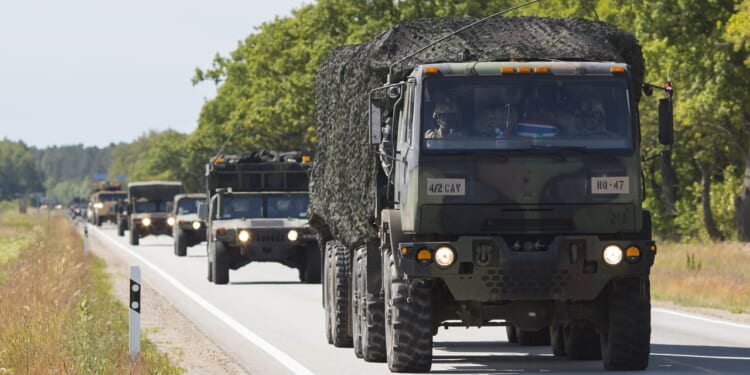By introducing autonomous systems into military convoys, Europe’s defense apparatus aims to reduce overall risk to personnel in the convoys.
Europe is desperate to prove that it can stand up on its own militarily. The European members of NATO not only want to prove that Europe can defend itself, but that it can innovate its own unique systems for military operations. Seville in Space recently hosted the final demonstration of a project that has produced what is being called Europe’s first autonomous military logistics convoy.
The project is called COMMANDS, an acronym for a program under the European Defense Fund. The demonstration was led by Sener Aerospace & Defense out of Spain in cooperation with other European defense-technology firms.
Wars Are Won and Lost Based on Logistics
Sener’s “Naviground” system was integrated with Indra’s Battle Management System, on logistic vehicle platforms built by IVECO Defense Vehicles and Defense Dynamics European Land Systems/Santa Bárbara Sistemas. Essentially, this new kind of military convoy demonstrated “follow-me” convoy mode (which is precisely as it sounds, basically automated vehicles followed a lead vehicle). There was a “last-mile shuttle” mode for delivering supplies to forward positions without a human driver.
The project has a budget of around €27 million, of which approximately 90 percent comes from the European Defense Fund, according to United24.
Logistics convoys comprise supplying ammunition, spare parts, fuel, and other essentials to forward-deployed combat units. They say often that men fight the wars but logistics wins them. Think back to World War II history. The scene is North Africa. Rommel. The Desert Fox. A superior tank tactician and master strategist, he chased the British Royal Army from Tripoli to Egypt.
The reason he lost that vital campaign: logistics. His supply chain became far too long and indefensible, allowing for daring Allied forces to effectively cut those lines as his iconic Panzers raced forward into the desert.
The same logic that dominated the North Africa campaign in 1941 dominates all modern wars today. How does one keep their armies supplied and moving forward—especially now that there are a number of pervasive threats seemingly designed to end-run whatever conventional defenses for supply convoys there are? Drones, advanced artillery, and ambush tactics of the kind that have defined the Ukraine War are today becoming ubiquitous across the world’s vast battlefields.
By introducing autonomous systems into military convoys, Europe’s defense apparatus aims to reduce overall risk to personnel in the convoys. Establishing autonomous ground vehicle operations for militaries is a technological leap: coordinating multiple vehicles, managing sensors, navigation, obstacle avoidance, and battlefield uncertainties. The Spanish system shows progress in these key domains.
For Spain (and Europe) this is about sovereign military capability. They emphasize that the system is entirely European-driven, reducing dependence on non-European defense technology. It could shape future military logistics doctrine: mixed convoys of crewed and uncrewed vehicles, last-mile unmanned delivery, and integration of autonomous systems into battlefield support operations.
The COMMANDS System Still Needs Work
Of course, the demonstration of this innovative system was performed in a controlled environment, not yet under full combat conditions with all the challenges (enemy action, degraded communications, extreme terrain).
What’s more, the degree of human supervision required (especially in contested environments) is still a question: optionally crewed suggests human involvement may still be significant. Indeed, given the complexities involved in orchestrating this system in a modern battlefield, some human factors may yet still be required.
Over time, however, it is possible the technology and tactics could be refined so that its full autonomous capabilities could be realized. Let us understand here, though, that supply convoys are but one part of military logistics. Integrating with wider systems (such as resupply under fire, battlefield recovery, and inter-theater transport) will need much more work.
In short, Spain, through Sener Aerospace & Defense (and its partners), has demonstrated what is being claimed as Europe’s first autonomous military logistic convoy system. While it is still at the demonstration stage, the capability signals a meaningful step toward integrating autonomous ground vehicles into military logistics. It has technological, operational and industrial implications and may foreshadow further developments in unmanned logistics for defense.
About the Author: Brandon J. Weichert
Brandon J. Weichert is a senior national security editor at The National Interest. Recently, Weichert became the host of The National Security Hour on America Outloud News and iHeartRadio, where he discusses national security policy every Wednesday at 8pm Eastern. He is also a contributor at Popular Mechanics and has consulted regularly with various government institutions and private organizations on geopolitical issues. Weichert’s writings have appeared in multiple publications, including The Washington Times, National Review, The American Spectator, MSN, and the Asia Times. His books include Winning Space: How America Remains a Superpower, Biohacked: China’s Race to Control Life, and The Shadow War: Iran’s Quest for Supremacy. His newest book, A Disaster of Our Own Making: How the West Lost Ukraine is available for purchase wherever books are sold. He can be followed via Twitter @WeTheBrandon.
Image: Shutterstock / StockPhotosLV.


















